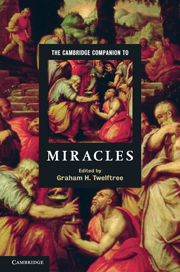Book contents
- Frontmatter
- Introduction
- Part I Fundamental issues
- Part II Miracles in antiquity and the Middle Ages
- 3 Miracles in the Hebrew Bible
- 4 Miracles in the Greek and Roman world
- 5 Miracles in Second Temple and early rabbinic Judaism
- 6 The miracles of Jesus
- 7 Miracles in early Christianity
- 8 Miracles In The Middle Ages
- Part III Miracles and major religions
- Part IV Miracle today
- Index
6 - The miracles of Jesus
from Part II - Miracles in antiquity and the Middle Ages
Published online by Cambridge University Press: 28 May 2011
- Frontmatter
- Introduction
- Part I Fundamental issues
- Part II Miracles in antiquity and the Middle Ages
- 3 Miracles in the Hebrew Bible
- 4 Miracles in the Greek and Roman world
- 5 Miracles in Second Temple and early rabbinic Judaism
- 6 The miracles of Jesus
- 7 Miracles in early Christianity
- 8 Miracles In The Middle Ages
- Part III Miracles and major religions
- Part IV Miracle today
- Index
Summary
To peruse Thomas Jefferson’s famous redaction of the New Testament, which excises the supernatural, is to be reminded of the prominence of the miraculous in the canonical gospels. There are stories in which Jesus is the object of a miracle. Also, Jesus is said to have uttered prophecies that are taken to be correct and to display knowledge that is portrayed as having a supernatural origin. Moreover, there are nine epiphanies of the risen Christ. Then, in the synoptic gospels Jesus’ disciples are credited with the power to exorcise, heal, and raise the dead. However, the number of traditions in any one of these categories is eclipsed by the miracles reportedly performed by Jesus. If parallel accounts are excluded, the gospels narrate, or refer to, at least thirty-five miracles performed by him. It is with these ‘miracles of Jesus’ that we will concern ourselves in this chapter.
Contemporary readers of the gospels reasonably ask if Jesus performed acts that he and others regarded as miracles. Further, if Jesus acted as a miracle worker, how did he understand the significance of this activity, and what relationship did he see between his miracle working and other aspects of his mission, including his proclamation of the kingdom of God?
The answers to these questions will be prefaced by a description of how Jesus’ miracle working is presented in the gospels. Since the portrayals of Jesus’ miracle working in the synoptic gospels are strikingly similar, we will first treat the synoptic tradition collectively before casting our gaze towards the Fourth Gospel.
- Type
- Chapter
- Information
- The Cambridge Companion to Miracles , pp. 113 - 130Publisher: Cambridge University PressPrint publication year: 2011
- 3
- Cited by



